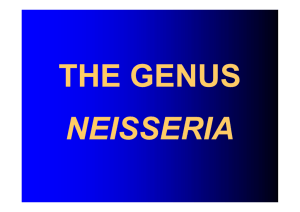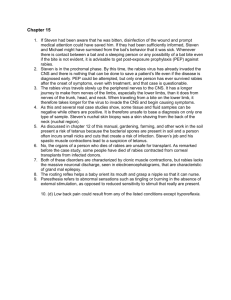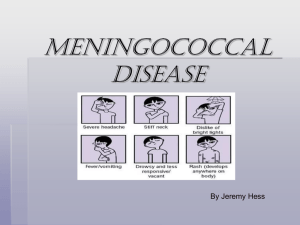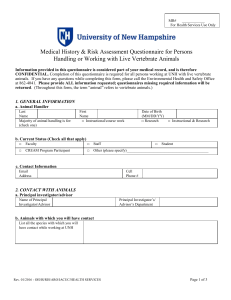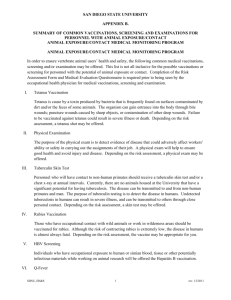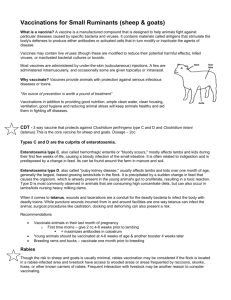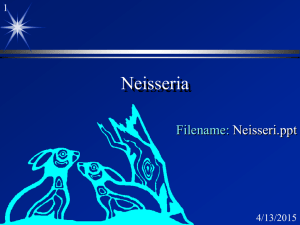Microbiology, 9e (Tortora) Chapter 22 Microbiology, 9e (Tortora
advertisement
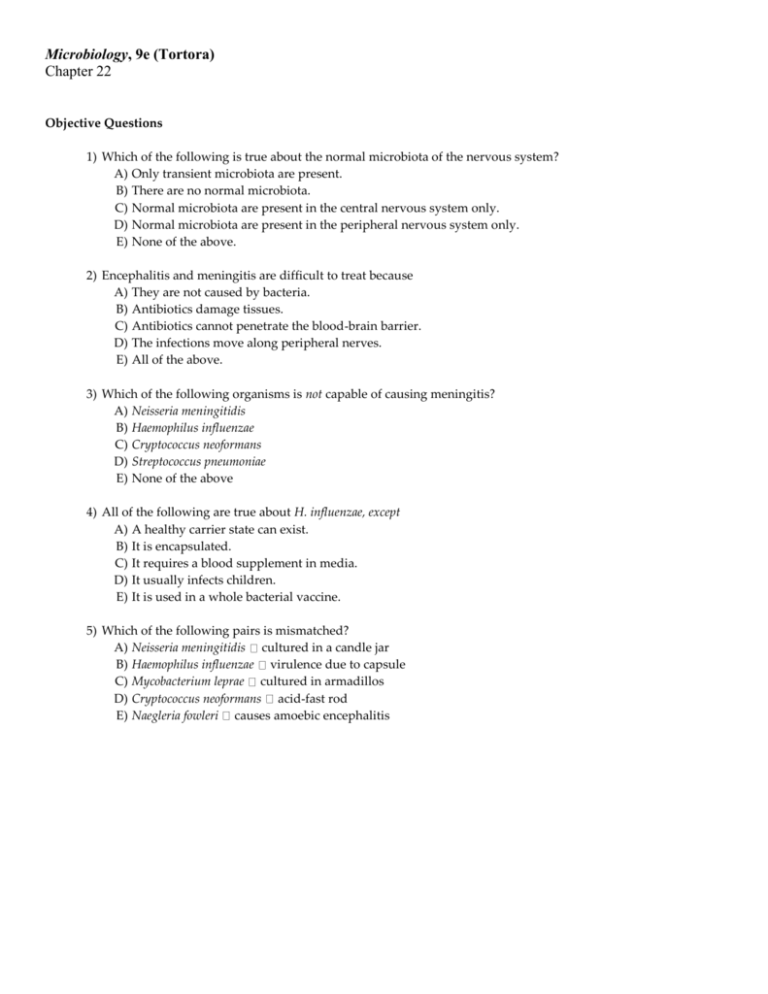
Microbiology, 9e (Tortora) Chapter 22 Objective Questions 1) Which of the following is true about the normal microbiota of the nervous system? A) Only transient microbiota are present. B) There are no normal microbiota. C) Normal microbiota are present in the central nervous system only. D) Normal microbiota are present in the peripheral nervous system only. E) None of the above. 2) Encephalitis and meningitis are difficult to treat because A) They are not caused by bacteria. B) Antibiotics damage tissues. C) Antibiotics cannot penetrate the blood-brain barrier. D) The infections move along peripheral nerves. E) All of the above. 3) Which of the following organisms is not capable of causing meningitis? A) Neisseria meningitidis B) Haemophilus influenzae C) Cryptococcus neoformans D) Streptococcus pneumoniae E) None of the above 4) All of the following are true about H. influenzae, except A) A healthy carrier state can exist. B) It is encapsulated. C) It requires a blood supplement in media. D) It usually infects children. E) It is used in a whole bacterial vaccine. 5) Which of the following pairs is mismatched? A) Neisseria meningitidis cultured in a candle jar B) Haemophilus influenzae virulence due to capsule C) Mycobacterium leprae cultured in armadillos D) Cryptococcus neoformans acid-fast rod E) Naegleria fowleri causes amoebic encephalitis Microbiology, 9e (Tortora) Chapter 22 6) Which of the following organisms is not correctly matched to the recommended treatment? A) Neisseria meningitidis cephalosporins B) Haemophilus influenzae cephalosporins C) Cryptococcus neoformans amphotericin B D) Mycobacterium leprae dapsone E) Poliovirus Salk vaccine 7) All of the following are true about leprosy except A) It is rarely fatal. B) Patients with leprosy must be isolated. C) It is transmitted by direct contact. D) Diagnosis may be based on the lepromin test. E) None of the above. 8) Which of the following is not transmitted by the respiratory route? A) N. meningitidis B) H. influenzae C) L. monocytogenes D) C. neoformans E) None of the above 9) All of the following are true about rabies except A) It is caused by Rhabdovirus. B) Hydrophobia is an early symptom. C) The reservoir is mainly rodents. D) Diagnosis is based on immunofluorescent techniques. E) It is not fatal in bats. 10) The symptoms of tetanus are due to A) Deep puncture wounds. B) Hemolysins. C) Lack of oxygen. D) Clostridial neurotoxin. E) All of the above. Microbiology, 9e (Tortora) Chapter 22 11) The treatment for tetanus is A) Penicillin. B) Antibodies. C) Toxoid. D) Cleansing the wound. E) There is no treatment. 12) A 30-year-old female was hospitalized after she experienced convulsions. On examination, she was alert and oriented and complained of a fever, headache, and stiff neck. Her symptoms could be due to all of the following except A) Clostridium botulinum. B) Listeria monocytogenes. C) Naegleria fowleri. D) Streptococcus pneumoniae. E) None of the above. 13) The most effective control of a vectorborne disease is A) Treatment of infected humans. B) Treatment of infected wild animals. C) Elimination of the vector. D) Avoidance of endemic areas. E) None of the above. 14) Treatment for tetanus in an unimmunized person is A) Tetanus toxoid. B) Tetanus immune globulin. C) Penicillin. D) DTP. E) None of the above. 15) Treatment for tetanus in an immunized person is A) Tetanus toxoid. B) Tetanus immune globulin. C) Penicillin. D) DTP. E) None of the above. Microbiology, 9e (Tortora) Chapter 22 16) The most common route of central nervous system invasion by pathogens is through A) The skin. B) The circulatory system. C) The gastrointestinal system. D) The parenteral route. E) Direct penetration into nerves. 17) The prodromal symptom(s) of meningitis is (are) A) Like a mild cold. B) Fever and headache. C) Stiff neck and back pains. D) Convulsions. E) Paralysis. 18) All of the following are requirements for an outbreak of botulism except A) Killing bacteria that compete with Clostridium. B) An anaerobic environment. C) An incubation period. D) A nutrient medium with a pH below 4.5. E) None of the above. 19) The most common cause of meningitis in children is A) Mycobacterium tuberculosis. B) Streptococcus pneumoniae. C) Cryptococcus neoformans. D) Haemophilus influenzae. E) Neisseria meningitidis. 20) Meningitis that begins as an infection of the lungs is caused by A) Flavobacterium meningosepticum. B) Streptococcus pneumoniae. C) Cryptococcus neoformans. D) Haemophilus influenzae. E) Neisseria meningitidis. Microbiology, 9e (Tortora) Chapter 22 21) Which of the following pairs is mismatched? A) Leprosy direct contact B) Poliomyelitis respiratory route C) Meningococcal meningitis respiratory route D) Rabies direct contact E) None of the above 22) A 30-year-old female was hospitalized after she experienced convulsions. On examination, she was alert and oriented and complained of a fever, headache, and stiff neck. Which of the following is most likely to provide rapid identification of the cause of her symptoms? A) Gram stain of cerebrospinal fluid B) Gram stain of throat culture C) Biopsy of brain tissue D) Check serum antibodies E) None of the above; it can't be diagnosed 23) All of the following are caused by prions except A) Sheep scrapie. B) Kuru. C) Creutzfeldt-Jakob disease. D) Transmissible mink encephalopathy. E) Rabies. 24) Which of the following is (are) not correctly matched? A) B) C) D) E) 1, 2, and 3 4, 5, and 6 1 and 3 2 None of the above Microbiology, 9e (Tortora) Chapter 22 25) All of the following are true about the lepromin test except A) It consists of human tissue extract. B) It detects the presence of anti-M. leprae antibodies. C) It is negative in the lepromatous form. D) It consists of M. leprae. E) None of the above. 26) Purplish spots on the skin are characteristic of an infection by A) C. neoformans. B) H. influenzae. C) N. meningitidis. D) S. pneumoniae. E) M. leprae. 27) A 1-year-old female was hospitalized with fever, lethargy, and rash. Gram-negative, oxidase-positive cocci were cultured from her cerebrospinal fluid. Her symptoms were caused by A) A prion. B) Clostridium tetani. C) Mycobacterium leprae. D) Neisseria meningitidis. E) Rabies. 28) A 1-year-old female was hospitalized with fever, lethargy, and rash. Gram-negative, oxidase-positive cocci were cultured from her cerebrospinal fluid. All of the following are true about the microbe responsible for her symptoms except it may A) Be normal in the cerebrospinal fluid. B) Be normal in the throat. C) Be treated with antibiotics. D) Cause epidemics. E) None of the above. 29) On June 30, a 47-year-old man was hospitalized with dizziness, blurred vision, slurred speech, difficulty swallowing, and nausea. Examination revealed facial paralysis. The patient had partially healed superficial knee wounds incurred while laying cement. Cultures taken from the knee wounds should be incubated A) Aerobically. B) Anaerobically. C) In 5-10% CO2. D) In animal cell culture. E) Any of the above will work. 30) A diagnosis of rabies is confirmed by A) Gram stain. B) Direct fluorescent-antibody test. C) Patient's symptoms. D) Passive agglutination. E) Patient's death. Microbiology, 9e (Tortora) Chapter 22 31) Which of the following is treated with antibiotics? A) Botulism B) Tetanus C) Streptococcal pneumonia D) Polio E) All of the above 32) Microscopic examination of cerebrospinal fluid reveals gram-negative rods. What is the organism? A) Haemophilus B) Listeria C) Naegleria D) Neisseria E) Streptococcus 33) Microscopic examination of cerebrospinal fluid reveals amoebae. What is the organism? A) Haemophilus B) Listeria C) Naegleria D) Neisseria E) Streptococcus 34) Microscopic examination of cerebrospinal fluid reveals gram-positive rods. What is the organism? A) Haemophilus B) Listeria C) Naegleria D) Neisseria E) Streptococcus Microbiology, 9e (Tortora) Chapter 22 35) On June 30, a 47-year-old man was hospitalized with dizziness, blurred vision, slurred speech, difficulty swallowing, and nausea. Examination revealed facial paralysis. The patient had partially healed superficial knee wounds incurred while laying cement. He reported eating home-canned green beans and stew containing roast beef and potatoes 24 hours before onset of symptoms. The patient should be treated with A) Antibiotics. B) Antitoxin. C) Surgery. D) Vaccination. 36) On October 5, a pet store sold a kitten that subsequently died. On October 22, rabies was diagnosed in the kitten. Between September 19 and October 23, the pet store had sold 34 kittens. Approximately 1000 people responded to health-care providers following local media alerts. These people were given A) Antibiotics. B) Antirabies immunoglobulin. C) Rabies vaccination. D) Serological tests for rabies. E) Treatment if they tested positive. 37) A vaccine is available for all of the following except A) Haemophilus meningitis. B) Neisseria meningitis. C) Tetanus. D) Rabies. E) Botulism. 38) Patients with leprosy usually die from A) Brain damage. B) Loss of nerve function. C) Tuberculosis. D) Influenza. E) Leprosy. 39) Which of the following is not acquired by ingestion? A) Botulism B) Cryptococcosis C) Listeriosis D) Poliomyelitis E) None of the above Microbiology, 9e (Tortora) Chapter 22 40) Which of the following statements is not true? A) The lepromin test is positive during tuberculoid leprosy. B) Leprosy is highly contagious. C) Loss of nerve sensation occurs in tuberculoid leprosy. D) Disfiguring nodules and deformation occur in lepromatous leprosy. E) Spontaneous recovery occurs in tuberculoid and borderline leprosy. 41) Which of the following pairs is not correctly matched? A) Tetanus blocks relaxation nerve impulse B) Botulism stimulates transmission of nerve impulse C) Poliomyelitis kills CNS cells D) Rabies virus grows in brain cells E) None of the above 42) Which of the following is not transmitted by ingestion? A) Poliomyelitis B) Listeriosis C) Botulism D) Meningococcal meningitis E) Creutzfeldt-Jakob disease 43) Which of the following vaccines is a cause of the disease it is designed to prevent? A) Tetanus toxoid vaccine B) Oral polio vaccine C) Inactivated polio vaccine D) Haemophilus influenzae capsule vaccine Microbiology, 9e (Tortora) Chapter 22 Situation 22.1 On July 5, an 11-year-old girl complained of pain in the knuckles of her left hand. During July 6-7, she had increasing pain that extended up to the left shoulder. A throat culture was obtained and amoxicillin was prescribed. On July 9, she had difficulty walking and hallucinations. The throat culture was positive for Streptococcus pyogenes. She was treated with ceftriaxone. On July 11, she was hospitalized with a temperature of 40.7°C and she could not drink. She developed respiratory distress and tachycardia; she died from cardiac arrest. Fluorescent antibody testing of brain tissue revealed inclusions in the brain stem. 44) In Situation 22.1, the antibiotics did not cure her disease because the pathogen was A) A virus. B) Already growing in her brain. C) Part of her normal microbiota. D) Protected by the blood-brain barrier. E) Resistant to antibiotics. 45) The disease described in Situation 22.1 is A) Botulism. B) Meningitis. C) Rabies. D) Streptococcal sore throat. E) Tetanus.
